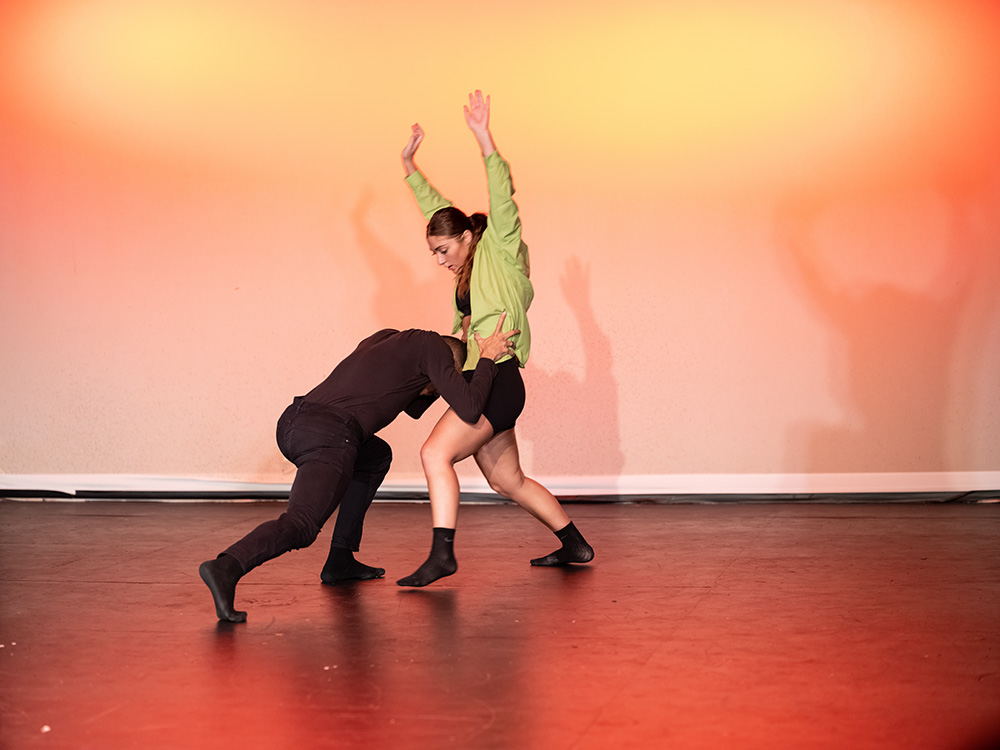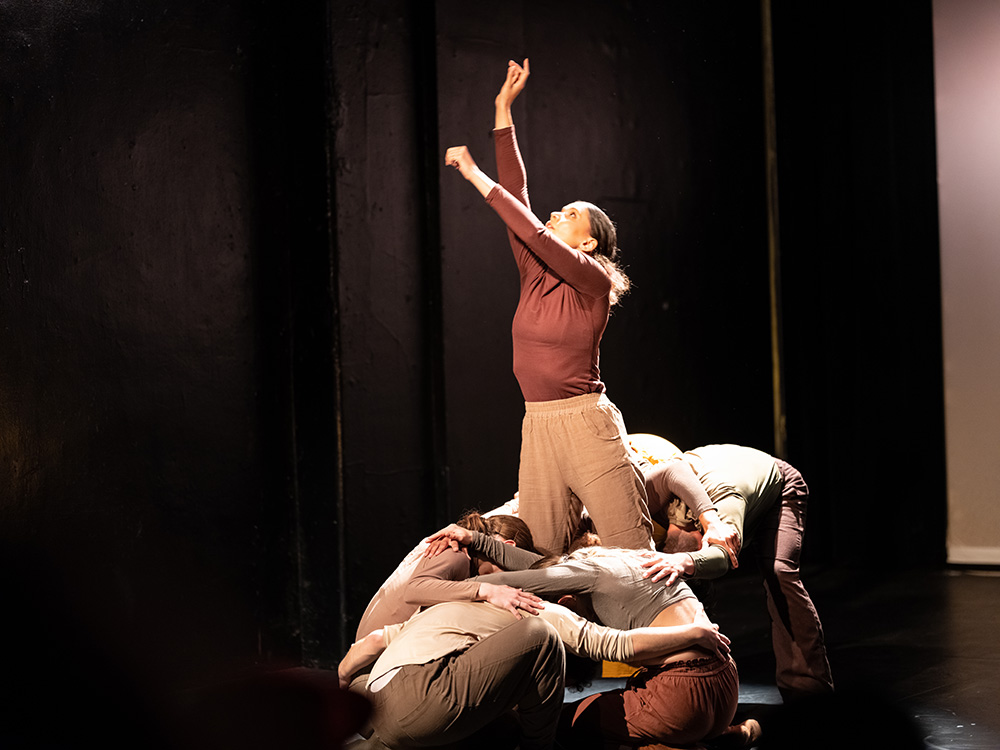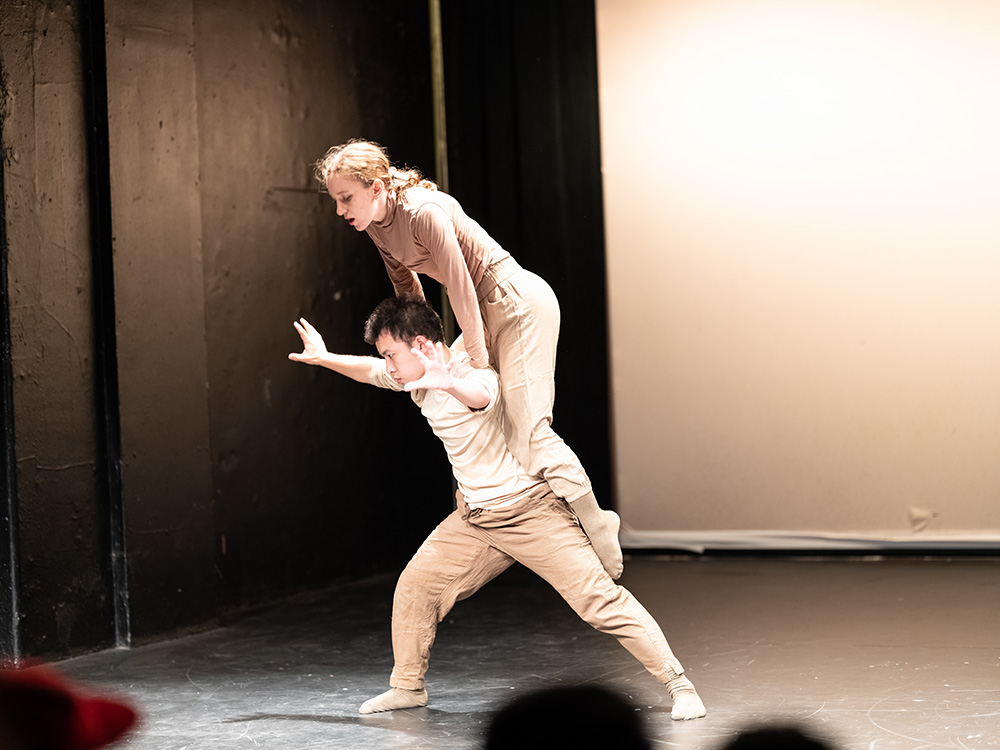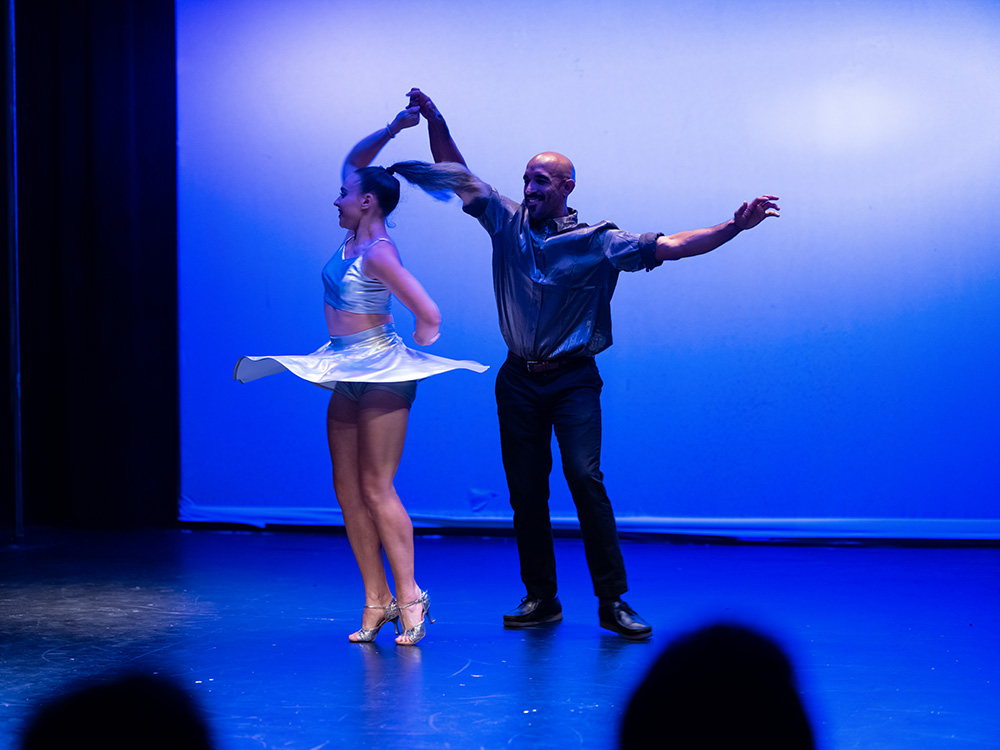Faustine Lavie’s most recent choreography ‘Banned’ was part of her first full-length show ‘Works’, which premiered in New York on October 14, 2022, as part of The Emerging Artists Theater’s ‘The New Work Series’. This production gives artists the opportunity to present their work-in-progress, afterwards engaging in a meaningful talkback session with audience, director, cast and curator. During the talkback, when asked about what piece felt most powerful, the audience brought up ‘Banned’. “It made me feel so uncomfortable,” said one person from the public. “I had a knot in my stomach,” said another. Faustine is satisfied: “If they felt uncomfortable, it means I did my job well.”
Lavie did extensive research to create this piece. Inspired by the events that lead the abolition of abortion rights in some US states, a decision mostly made by men, ‘Banned’ denounces the patriarchal world and the inequalities between men and women. The female dancers (Manon Bal, Mathilde Guerrero, Irene Paci, Sarah Perez, Erica Welty and Annie White) wear colorful button-down shirts over black shorts in that piece. “They all wear different colors because I wanted to highlight how all women are different, even if they are in the same situation,” Faustine explains. Their movements express the pain and suffering; at the same time, these dancers never stop supporting each other. They move throughout space and levels, expressing the strength, resilience and nourishment that stems from sisterhood. The choreography tells stories both of male dominance and male protection.

The Faustine Lavie Dance Project performs ‘Banned’. © SDF Media 2022
The male dancers (Isaac Kerr, Rayan Lecurieux-Durival, Tsubasa Nishioka and Caleb Patterson) are dressed in total black, with long pants and long-sleeved button-down shirts: a choice that highlights the sharp contrast and opposing energy present on stage.
As the male and female dancers interact, the effect is intense and gripping. The lighting design adds to the dramatic feeling but does not overwhelm: the different shades of blue and orange fit that purpose precisely. “Woman” (2019) by Yann Arthus-Bertrand Anastasia Mikova, was one of the documentaries that most touched Lavie during her research, and she pays homage to it in the music chosen for ‘Banned’, featuring tracks by Armand Amar and Kenji Kawai.
‘Banned’ followed two pieces Lavie had started working on during the pandemic, and performed this past year: ‘Outburst’ and ‘Memoirs from Another Life’.

The Faustine Lavie Dance Project performs ‘Outburst’. © SDF Media 2022
The first time she heard the band Wardruna it was in the TV show “Vikings”. She downloaded all their albums and dove deep into their sounds. As she listened to the song ‘Tyr’, images of movement flooded her mind. The choreographic vision led to the concept, and thus gave birth to ‘Outburst’. “I like the visceral feeling of the music, and it goes well with the feeling of escaping the ‘labels’ that society puts on you,” she says. The piece is a powerful reflection on the conflict between our inner instincts and society standards. The first piece presented in her full-length show has been performed before, and originally featured nine dancers. In ‘Works’, Lavie’s use of staging in the choreography makes the ensemble (Manon Bal, Mathilde Guerrero, Tsubasa Nishioka, Caleb Patterson, Erica Welty, Annie White) feel twice as big and keeps the force and essence of the piece intact. The dancers go from performing lifts to floorwork, Lavie’s passion, using up all the space, exiting the stage and returning. At one point they huddle together so closely all one can see is a uniform mass from which, suddenly, a hand appears. The hand belongs to Bal, her fingers eloquently express the desire of self-expression and captivate the audience, telling the story of the conflict between individual instinct and conformity to society. The neutral earth-tone colors and loose-fitting style of the clothes draw attention to the complex movement and the dancers’ expressiveness, highlighting the raw feeling of the piece. As a choreographer, Lavie strikes a good balance between giving direction while leaving her dancers much room for interpretation: their individuality shines as they perform their solos. The partner-work is flawless: Annie White and
Tsubasa Nishioka, and Mathilde Guerrero and Caleb Patterson interact seamlessly. There is no uncertainty or wavering in their connection as the couples move as one. “That is something that I had the dancers work on a lot in rehearsal. It is very important to me that partner-work flows without hesitation, and I had the dancers repeat those sections until I was satisfied. I’m a bit of a perfectionist on that,” Lavie concedes with a smile.

The Faustine Lavie Dance Project performs ‘Outburst’. © SDF Media 2022
‘Memoirs of Another Life’ was a solo Faustine originally choreographed on herself. “Having another dancer perform it was definitely interesting” she admits. “Since originally it was choreographed on myself, it was based on my style of movement. All dancers move differently so it was interesting to guide somebody to execute my own quality of movement while also allowing for their own interpretation.” She brought some of herself in the piece through the lighting design, though, choosing her favorite color, purple, to reflect her feelings. The piece is very personal to the choreographer and explores the range of emotions felt when was unable to return to her hometown for over four years, between the pandemic and the visa renewal process. In this piece, the music and the movement developed together. ‘Rise Again’ by Florian Scarpa and Benjamin Le Bars was composed specifically for this piece, and the process involved a continuous sharing of music and choreography amongst the artists until the score was complete. Lavie worked closely with the composers to create a piece that spanned all the emotions she felt, from nostalgia and anger to appreciation of life’s everyday miracles and joy. Sarah Perez interprets the piece wonderfully, and gracefully embodies the journey from darkness to light. The piece also features the version of “What a Wonderful World” by Reuben And The Dark & AG, and Perez indeed makes you ultimately trust in the beauty of life.

Faustine Lavie and Gil Center perform a hustle routine. © SDF Media 2022
Faustine did not let her audience leave heavy-hearted, though. “Works” concludes with a joyful hustle performance by Lavie and her partner Gil Center. Dancing to the notes of Jamiroquai’s ‘Cosmic Girl’, she celebrates the hustle, a partner-dance style she learned in New York and has quickly fallen in love with. Shining in a silver glitter outfit, with Center in a matching suave metallic shirt, she spins and twirls impeccably across the stage and has the audience shouting out in approval. During the talkback she shares that her goal for her next piece is to develop a choreography that fuses both styles she is passionate about: hustle and contemporary.
The full length ‘Works’ premiere was a one-night-only event – for now. For those who missed it, there is still the opportunity to enjoy Lavie’s work during the month of November, while waiting for the next full-length production and her next project. On November 6th (click here for tickets and info), November 13th (click here for tickets and info), and November 20th (click here for tickets and info), The Faustine Lavie Dance Project will be performing excerpts of ‘Work’ across the boroughs on New York City.





